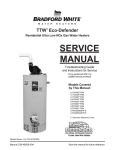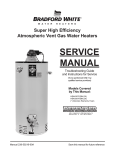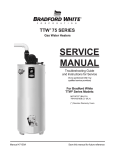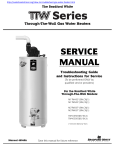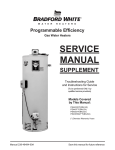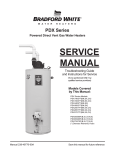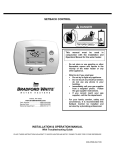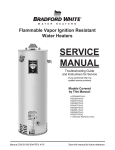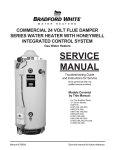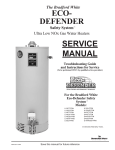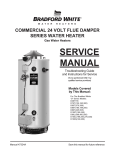Download Bradford White D4504S*F(BN Service manual
Transcript
Residential Flue Damper Gas Water Heaters SERVICE MANUAL Troubleshooting Guide and Instructions for Service (To be performed ONLY by qualified service providers) Models Covered by This Manual: D4403S*F(BN,SX) D4504S*F(BN,SX) (*) Denotes Warranty Years Manual 238-48385-00A Save this manual for future reference Table of Contents Section Page Introduction ______________________________________________5 How to Use this Manual _____________________________________6 Tools Required for Service ___________________________________6 Specifications _____________________________________________7 Sequence of Operation______________________________________9 Power Up Sequence Normal Heating Sequence Abnormal Operation Troubleshooting __________________________________________ 13 Burner Maintenance _______________________________________ 15 Burner Inspection Burner Cleaning Procedure Pilot Maintenance _________________________________________ 17 Pilot Inspection, Testing and Replacement Damper Replacement______________________________________ 19 Thermal Well Testing ______________________________________ 21 Determine Water Temperature Inside Tank_____________________ 22 Component Disassembly ___________________________________ 23 Gas Control Removal ______________________________________ 24 Gas Control Assembly _____________________________________ 25 Flammable Vapor Sensor Testing_____________________________ 27 120 VAC Circuit Trace _____________________________________ 27 Diptube Inspection ________________________________________ 28 Anode Inspection _________________________________________ 29 Damper Removal _________________________________________ 31 Inner Door Removal _______________________________________ 32 Inner Door Gasket Replacement _____________________________ 33 Inner Door Installation_____________________________________ 34 Arrestor Cleaning _________________________________________ 35 Damper Relay Installation __________________________________ 35 Common Terms __________________________________________ 38 Notes __________________________________________________ 38 Parts List _______________________________________________ 39 Page 2 2 WARNING If the information in these instructions is not followed exactly, a fire or explosion may result causing property damage, personal injury, or death. What to do if you smell gas: x Do not try to light any appliance x Do not touch any electrical switch; do not use any phone in your building x Immediately call your gas supplier from a neighbor’s phone. Follow the gas supplier’s instructions. x If you cannot reach your gas supplier, call the fire department. Installation and service must be performed by a qualified installer, service agency, or the gas supplier. DANGER Do not store or use gasoline or other flammable, combustible, or corrosive vapors and liquids in the vicinity of this or any other appliance. CAUTION Incorrect operation of this water heater may create a hazard to life and property and will nullify the warranty. If sweat fittings are to be used, DO NOT apply heat to the nipples on top of the water heater. Sweat the tubing to the adapter before fitting the adapter to the water connections. It is imperative that heat is not applied to the nipples containing a plastic liner. Turn off or disconnect the electrical power supply to the water heater before servicing. Label all wires prior to disconnection when servicing controls. Wiring errors can cause improper and dangerous operation. Verify proper operation after servicing. NOTICE Before proceeding, please inspect the water heater and its components for possible damage. DO NOT install any water heater with damaged components. If damage is evident, then please contact the supplier where the water heater was purchased or the manufac- Page 3 3 WARNING Water heaters are heat producing appliances. To avoid damage or injury, do not store materials against the water heater or any of its components. Use proper care to avoid unnecessary contact, especially by children, with the water heater and its components. Under no circumstances must flammable materials, such as gasoline or paint thinner be used or stored in the vicinity of this water heater or in any location in which the fumes could reach the water heater. Hydrogen gas can be produced in an operating water heater that has not had water drawn from the tank for a long period of time (generally two weeks or more). Hydrogen gas is extremely flammable. To prevent the possibility of injury under these conditions, we recommend a hot water faucet to be open for several minutes at the kitchen sink before you use any electrical appliance which is connected to the hot water system. If hydrogen is present, there will be an unusual sound such as air escaping through the pipes as hot water begins to flow. Do not smoke or have open flame near the faucet at the time it is open. DO NOT ATTEMPT TO LIGHT ANY GAS APPLIANCE IF YOU ARE NOT CERTAIN OF THE FOLLOWING: Liquefied petroleum gases/propane gas and natural gas have an odorant added by the gas supplier that aids in the detection of the gas. Most people recognize this odor as a “sulfur” or “rotten egg” smell. Other conditions, such as “odorant fade” can cause the odorant to diminish in intensity, or ”fade,” and not be as readily detectable. If you have a diminished sense of smell, or are in any way unsure of the presence of gas, immediately contact your gas supplier from a neighbor's telephone. Gas detectors are available. Contact your gas supplier, or plumbing professional for more information. FAILURE TO INSTALL AND MAINTAIN A NEW, LISTED 3/4” X 3/4” TEMPERATURE AND PRESSURE RELIEF VALVE WILL RELEASE THE MANUFACTURER FROM ANY CLAIM THAT MIGHT RESULT FROM EXCESSIVE TEMPERATURE AND PRESSURES. Page 4 4 Introduction The Bradford White DEFENDER Safety System® The Bradford White DEFENDER Safety System was designed to resist the ignition of flammable vapors that can occur outside of the water heater. Use and installation are nearly identical to previous versions of atmospherically fired and vented water heaters. A number of exclusive design features are incorporated in the system that will require additional knowledge on the part of the qualified service provider. The following information will instruct service professionals on the function, proper diagnosis, and repair of water heaters employing the Bradford White DEFENDER Safety System. Introduction The new Bradford White Residential Flue Damper water heaters are designed to provide reliable performance with enhanced standard features. New design features include reliable sparkto-pilot ignition system, enhanced diagnostics, simplified servicing, significantly quiet operation, and the Bradford White Defender Safety System. Spark-to-Pilot Ignition System - employing the spark-to-pilot ignition system promotes reliable and consistent pilot and main burner ignitions to provide hot water on demand. Integrated Immersion Thermal Well/Gas Control with LED - was developed for ease of troubleshooting by providing simple diagnostic codes to pinpoint an installation or component performance issue. Rugged Wiring Connections - receptacle type connections promote error free wiring. The gas control maintains water temperature, ignition sequence, and regulates gas flow. If a situation outside of normal operating parameters exists, the gas control diagnostic LED will flash a code to positively identify an operational issue. This service manual is designed to facilitate problem diagnosis and enhance service efficiency. To further promote quicker service times, the gas control can be removed and replaced without draining the water heater. A special tool is required and will be provided with each gas control kit shipped from your Bradford White wholesale distributor. Please read the service manual completely before attempting service on this new series of damper models. How the Safety System Works During normal operation, air for combustion is drawn into the water heater through the openings in the jacket. This air travels down and around the combustion chamber and enters through holes in the very bottom of the corrosion resistant combustion chamber. The air then travels up through the flame arrestor louvers, where the velocity of the air is increased and its direction altered. The air then mixes in a normal manner with supplied gas and is efficiently combusted, producing very low NOx emissions. In the unlikely event trace amounts of flammable vapors are present in the air flowing into the Page 5 5 How to Use this Manual combustion chamber, the vapors are harmlessly ignited by the burner. If flammable vapors are in sufficient quantity to prevent normal combustion, the flammable vapor sensor recognizes this and shuts down the pilot and main burner. Should the flammable vapors continue to burn, the flame arrestor prevents the flames from traveling backwards and igniting vapors outside of the combustion chamber. And, the resettable thermal switch will open and shut down the pilot and main burner. How to Use this Manual It is intended for this manual to be used by qualified service personnel for the primary purpose of troubleshooting and repair of the Bradford White Residential Flue Damper water heaters. Understanding the sequence of operation section of this manual will contribute greatly to troubleshooting the water heater. The Honeywell WV4460E Electronic Gas Control will display error codes in the event of abnormal operation. Error codes are listed in the troubleshooting chart beginning on page 13 of this service manual. The troubleshooting chart will also indicate the probable cause for the error code and direct the service professional to a service procedure to properly diagnose the abnormal operation. Contact the Bradford White technical support group immediately if diagnosis cannot be made using the methods described in this service manual. Tools Required for Service Manometer: A liquid “U” tube type or a digital (magna-helic) type can be used. This device is used to measure gas and/or air pressure and vacuum. Multi-Meter: A digital type is strongly recommended. This device is used to measure electrical values. The meter you select must have the capability to measure volts AC, volts DC, amps, micro-amps and ohms. Electronic Probes: In some cases, standard multi-meter probes will damage or simply not be effective to obtain certain voltage and ohm reading. It will be necessary to have special electronic “pin” type multi-meter probes. These probes are available at most electronic wholesale outlets. Thermometer: Used to measure water temperature. An accurate thermometer is recommended. Water Pressure Gage: Used to measure water supply pressure. Also used to determine tank pressure by adapting to the drain valve of the heater. Gas Control Service Tool: BWC part number 239-45991-00. A specialized tool designed to remove the gas control from gas control thermal well. Available from your Bradford White parts supplier. Various Hand Tools: Pipe wrench, channel locks, open end wrenches (3/8", 7/16", 1/2"), 12" crescent wrench, Allen wrench set, screw drivers (common & Phillips), 1/4" nut driver, pliers (common & needle nose), socket set, side cutters, wire cutters, wire strippers, wire crimpers, torpedo level, small shop vac, step ladder, flashlight, and 5 gallon pail. Page 6 6 Specifications Power Supply Gas Supply Pipe Dedicated 120VAC, 60 Hz, 15A Minimum 1/2” NPT (Schedule 40 black iron pipe recommended) Approved Gas Type Natural or Propane; unit must match gas type supplied Gas Pressure 5” w.c. minimum for Natural Gas; 11” w.c. for Propane; 14” w.c. maximum for Natural Gas / Propane Approved Vent Materials Single or Double Wall Metal Vent Pipe Minimum Clearance for Servicing 18” from top; 24” from front; 4” from sides and rear Water Supply Pressure 150 psi maximum allowable working pressure; check local codes for supply pressure ECO Limit 188°F (87°C) Temperature Setpoint Range 60°F (16°C) to 160°F (71°C); approximate temperatures Page 7 7 Specifications Control Timings Ignition State Timing Adjust Damper Position and Verify (Open Position) 15 seconds Trial for Ignition 90 seconds Flame Stabilization Period 3 seconds Re-adjust Damper Position and Verify 15 seconds 1.5 seconds (2 second maximum; 1 second minimum) Flame Failure Response Time Adjust Damper Position and Verify (Closed Position) 15 seconds Damper Blade Position Fault (failed open/close) Retry after 2 minutes Soft Lockout Retry after 5 minutes ECO Limit Lockout Verify Resistive Delay Simulated Resistive Load Lockout Hardware Error Lockout Indefinite (See page 11 to reset) Retry after 2 minutes (repeats 5 times) Indefinite (cycle power to reset) Indefinite (self clears if fault clears for at least 15 seconds) Wiring Diagram Page 8 8 Sequence of Operation Power Up Sequence 1. Start-up: Upon power up, the gas control runs a safe start check with a typical delay of 5 seconds. 2. Flammable Vapor Verification: The gas control verifies that the Flammable Vapor Sensor is in the proper operating range prior to energizing any components. If the sensor is within the proper range, the gas control resumes normal operation. If the Flammable Vapor Sensor is out of range, the gas control LED immediately flashes 7 times with a 3 second pause. Normal Heating Sequence When the phrase “Damper Open” is used, this means that the damper blade is in the vertical position (open). Alternatively, “Damper Closed” means that the damper blade is in the horizontal position (closed). This must not be confused with the phrase “Damper Circuit Open,” as this means that the damper blade is in the horizontal position. “Damper Circuit Closed” means that the damper blade is in the vertical position, and the water heater can proceed to an ignition trial. 1. Thermostat Calls for Heat: Prior to energizing the damper, the gas control verifies the damper safety circuit to see if it is in the correct state. If the safety circuit is closed, the gas control LED flashes 2 times with a 3 second pause. The gas control waits 2 minutes. Then, the damper is powered closed. This cycle repeats until the safety circuit opens. 2. Damper Powered Open 3. Damper Safety Circuit Check: If the damper safety circuit does not close within 30 seconds, the gas control LED flashes 3 times with a 3 second pause. The damper is powered open for a maximum of 30 seconds every 2 minutes trying to close the damper safety circuit. This cycle repeats as long as there is a call for heat. 4. Damper Hold Period (15 seconds) 5. Trial for Pilot Ignition (90 seconds): The gas control lights the pilot by activating the spark igniter and gas flow to the pilot burner. If flame is not sensed within 90 seconds, the spark igniter and gas flow are deactivated. The damper will remain open, and the gas control LED flashes 6 times with a 3 second pause. 6. Main Burner Ignition: After pilot flame is sensed, the gas control activates the main valve for main burner ignition. The gas control will ignore flame signals for 3 seconds to allow for the main burner to stabilize. Page 9 9 Sequence of Operation Normal Heating Sequence (cont’d) 7. Steady State Operation: During steady state operation, the gas control monitors: Thermostat Temperature Sensor: When the setpoint temperature is satisfied, the gas control is shutdown, and the damper is powered closed. The gas control LED flashes a short flash once every 4 seconds (Idle status code). Damper Position: If the damper position is altered during a call for heat, the pilot and main valves are shutdown. The damper is powered open attempting to close the damper safety circuit. The gas control LED flashes 3 times with a 3 second pause. Flame Sensor: If flame is lost, the pilot and main valves are shutdown. The damper is powered open. The gas control attempts to re-light the pilot 4 times. If unsuccessful, the damper is closed, and the gas control proceeds to a 5 minute lockout. The gas control re-attempts to light the pilot starting at Normal Heating Sequence #2. 8. Thermostat Satisfies: Gas control LED flashes once every 4 seconds. 9. Burner Off 10. Damper Powered Closed (15 seconds) Abnormal Operation 1. Flammable Vapor Sensor Fault: A) If the resistance is greater than 70,000 ohms: The gas control immediately turns off all outputs. The gas control waits and monitors resistance for 30 seconds. If the resistance is greater than 65,000 ohms after 30 seconds, the gas control proceeds to verify resistive delay for 2 minutes and flashes 7 times then 1 time with a three second pause. This process is repeated 5 times until the control either returns to normal operation or proceeds to flammable vapor lockout. B) If the resistance is below 3000 ohms: The gas control immediately turns off all outputs and proceeds to flash 8 times then 1 time with a three second pause. The error self clears if the resistance returns to normal range for at least 15 seconds. Page 10 10 Sequence of Operation Abnormal Operation (cont’d) 2. Temperature Sensor Fault: A) Temperature Sensor Open Circuit: The gas control immediately turns off all outputs and proceeds to flash 8 times then 3 times with a three second pause. The error self clears if the fault clears for at least 15 seconds. B) Thermal well sensors not reading the same temperature within ±5.5°F: The gas control immediately turns off all outputs and proceeds to flash 8 times then 3 times with three second pause. The error self clears if the fault clears for at least 15 seconds. C) Water Temperature in excess of ECO (Energy Cut Off) Limit: The gas control immediately turns off the pilot and main valves. The gas control LED proceeds to flash 4 times with a 3 second pause. To reset the gas control, rotate the setpoint knob to the minimum setting for at least 6 seconds before returning to desired temperature setting. 3. Damper Safety Circuit Fault: A) Damper Failed to Open: The gas control proceeds to flash 3 times with a three second pause. The gas control waits 5 minutes, and then tries to open the damper again. B) Damper Failed to Close: The gas control proceeds to flash 2 times with a three second pause. The gas control waits 5 minutes, and then tries to open the damper again. 4. Trial for Ignition Fault: A) Damper Jostled During Trial: The gas control stops the trial for ignition. The gas control proceeds to flash 3 times with a three second pause. The gas control waits 5 minutes, and then tries to open the damper again. B) Flame Not Sensed: The gas control energizes the spark igniter attempting to light the pilot and prove flame. If flame is not sensed within 90 seconds, the spark igniter turns off, the pilot valve is closed. The gas control LED flashes 6 times then 1 time with 3 second pause. The control waits 5 minutes before repeating the ignition sequence. Page 11 11 Sequence of Operation Abnormal Operation (cont’d) 5. Flame Sensing Fault: A) Flame Lost During Run: The gas control turns off pilot and main valves. The gas control increments the recycle count, if the recycle count has not reached its limit (4), another trial for ignition begins. If the recycle count has been reached, the gas control LED flashes 6 times then 3 times with a 3 second pause. The gas control waits 5 minutes before repeating the ignition sequence. B) Flame Sensed Out of Sequence: The gas control only looks for pilot flame when the damper is in the open position. If flame is present when the pilot valve is not open, the gas control proceeds to wait for flame loss and flashes 5 times with 3 second pause. This continues until flame is lost. Once the flame signal is lost, the control flashes 6 times then 4 times with a 3 second pause. The control waits 5 minutes before repeating the ignition sequence. Page 12 12 Troubleshooting Observe the green LED on the water heater gas control. Error codes are displayed with a 3 second pause before repeating. Once the error code is known, check and repair the water heater, as recommended in the table below. Green LED LED Status Control Status Probable Cause Service Procedure Control power switch in "OFF" None (LED Electrical power not position. not on or Turn Power On present Supply voltage interrupted. flashing) Stand-by mode, One short Temperature demand is satisfied Normal operation Thermostat is flash every (no call for heat) four seconds satisfied (no faults) Alternates bright and Thermostat calling Tank temperature below Normal operation dim for heat (no fault) setpoint of thermostat (heartbeat) Short flash once every second 1. Unstable pilot 2. Pilot tube blocked or restricted 3. Oxidation build-up on pilot Weak pilot signal electrode on last call for heat 4. Wire damage to pilot assembly or bad connection at gas control 1. See Burner Inspection on page 15 2-4. See Pilot Inspection, Testing and Replacement on page 17 1. Verify cord sets are fully plugged in 2. Verify switch on damper is in "Automatic" position 3. Verify that damper and venting is not obstructed 1. Verify cord sets are fully 1. Damper not in proper position plugged in Three or malfunctioning - not reaching 2. Verify switch on damper is Damper test circuit flashes, full open position in "Automatic" position not working three second 2. Obstructed venting 3. Verify that damper and pause 3. Faulty damper venting is not obstructed 1. Test Gas Control & Thermal Excessive tank 1. Thermal well sensor out of Four flashes, Well temperature, calibration three second 2. Replace gas control if system must be 2. Faulty gas control pause necessary reset 1. Damper not in proper position Two flashes, or malfunctioning - stuck in open Damper test circuit three second position not working 2. Obstructed venting pause 3. Faulty damper Five flashes, three second pause False pilot flame present Six flashes, Failed to light pilot, one flash, three second system resets after (5) minutes pause (Soft Lockout) Pilot valve stuck in open position Replace gas control 1. Unstable pilot 2. Pilot tube block or restricted 3. Oxidation build-up on pilot electrode 4. Wire damage to pilot assembly or bad connection at gas valve 1. See Burner Inspection on page 15 2-4. See Pilot Inspection, Testing and Replacement on page 17 Page 13 13 Troubleshooting LED Status Control Status Damper test circuit Six flashes, not w orking two flashes, properly during three second burner operation, pause (Soft system auto resets Lockout) after (5) minutes Six flashes, three Pilot flame flashes, extinguished, three second system auto resets after (5) minutes pause (Soft Lockout) Probable Cause 1. Damper not in proper position or malfunctioning - damper moved from full open position during run cycle 2. Obstructed venting 3. Faulty damper 4. Damper jostled during run cycle 1. Unstable pilot 2. Pilot tube block or restricted 3. Oxidation build-up on pilot electrode 4. Wire damage to pilot assembly or bad connection at gas control 5. Insufficient combustion air 6. Insufficient gas pressure Service Procedure 1. See Burner Inspection on page 15 2-4. See Pilot Inspection, Testing and Replacement on pate 17 1. See Burner Inspection on page 15 2-4. See Pilot Inspection, Testing and Replacement on page 17 5. Refer to Installation & Operation Manual Six flashes, Undesired false four flashes, pilot flame sensed, Pilot valve stuck in open position Replace gas control three second system auto resets pause Flammable vapor Seven sensor or flashes, resettable thermal sw itch fault three second detected, see pause warning label Eight flashes, one flash, three second pause Flammable vapor sensor out of specification, possible short 1. Flammable vapor present 2. Flammable vapor sensor exposed to excessive moisture 3. Flammable vapor sensor exposed to extreme ambient temperature 4. Resettable thermal sw itch open 1. Flammable vapor sensor out of specification; verify Flammable Vapor Sensor (FVS) resistance is not below 25 k. 2. Possible short in flammable vapor sensor or resettable thermal sw itch wiring See Flammable Vapor Sensor Testing on page 27 See Flammable Vapor Sensor Testing on page 27 1. Damage to thermal w ell w ires 2. Thermal well sensor Eight Thermal w ell sensor resistance out of range flashes, 3. Replace thermal w ell damaged or See Thermal Well Testing three unplugged or gas 4. Verify control is not w et or on page 21 flashes, control electronics physically damaged three second 5. Reset control on/off switch fault detected pause 6. Replace gas control if 8-3 error persists Eight flashes, four flashes, three second pause Page 14 14 Gas control fault detected 1. Verify control is not w et or physically damaged 2. Reset control on/off switch 3. Replace gas control if 8-4 error persists 1. Replace gas control if w et or physically damaged 2. Cycle power 3. Replace gas control Burner Maintenance Burner Inspection At periodic intervals (every 6 months), a visual inspection should be made of the pilot and main burner for proper operation and to assure no debris is accumulating. The pilot flame should be stable. Some causes for an unstable pilot flame are: a) Gas pressure is out of specification. b) Pilot flame not fully engulfing spark/flame sensor. The main burner should light smoothly from the pilot and burn with a blue flame with a minimum of yellow tips. Steel burner models self adjust air to gas ratio mixture and do not have an adjustable air shutter. The main burner must be free from any debris accumulation that may effect burner operation (See Burner Cleaning Procedure on page 15). Burner Cleaning Procedure Step 1. position. Move the gas control power switch to the “OFF” Gas control power switch Step 2. Unplug the water heater from the wall outlet. Damper (water heater) power cord Step 3. Turn off the gas supply to the water heater. Step 4. Remove the outer door. Outer door Page 15 15 Burner Maintenance Burner Cleaning Procedure (cont’d) Step 5. Remove the (4) 1/4” hex drive screws holding the right side inner door in place. (4) 1/4” hex drive screws Right side inner door Step 6. Disconnect the pilot tube using a 7/16” wrench and the main burner feedline with a 3/4” wrench from the gas control. Pilot and main feedlines Step 7. Disconnect the spark igniter/flame sensor wire from gas control. Gas control Spark igniter/flame sensor wire Step 8. chamber. Remove the burner assembly from the combustion Burner assembly Burner surface area and burner ports Step 9. Thoroughly inspect the burner surface area and burner port area and remove any loose debris. Step 10. Unscrew the burner from the main burner orifice. Main feedline Step 11. Remove the main burner orifice from the main feedline using a 1/2” wrench. Inspect the orifice and clean or replace, if necessary. 1/2” wrench Page 16 16 Main burner orifice Pilot Maintenance Burner Cleaning Procedure (cont’d) Step 12. Reassemble the burner assembly and reinstall into the water heater. Restore gas supply and check for gas leaks. Step 13. To resume operation, follow the instructions located on the water heater lighting instruction label. Or, use the lighting instructions located in the water heater installation and operating manual. Pilot Inspection, Testing and Replacement Step 1. position Move the gas control power switch to the “OFF” Gas control power switch Step 2. Unplug the water heater from the wall outlet. Damper (water heater) power cord Step 3. Turn off the gas supply to the water heater. Step 4. Remove the outer door. Outer door Step 5. Remove the (4) 1/4” hex drive screws holding the right side inner door in place. (4) 1/4” hex drive screws Right side inner door Step 6. Disconnect the pilot tube using a 7/16” wrench and the main burner feedline with a 3/4” wrench from the gas control. Pilot and main feedlines Page 17 17 Pilot Maintenance Pilot Inspection, Testing and Replacement (cont’d) Step 7. Disconnect the spark igniter/flame sensor wire from gas control. Gas control Spark igniter/flame sensor wire Step 8. chamber. Remove the burner assembly from the combustion Burner assembly Step 9. Remove the pilot assembly from the main feedline using a 1/4" nut driver. Pilot assembly 1/4” nut driver Step 10. Visually inspect the spark igniter/flame sense wire for damage. Replace the pilot assembly, if damage is found. Step 11. With a multi-meter set to the ohms setting, check continuity through the spark igniter/flame sense wire. Replace the pilot, if there is no continuity. Multi-meter Step 12. Visually inspect the spark igniter/flame sense electrode for deterioration. Replace the pilot assembly, if necessary. The electrode should not be in contact with pilot hood. If it is in contact with the pilot hood, carefully adjust electrode to a gap distance of 3/32" from the pilot hood. Step 13. Visually inspect the spark igniter/flame sense electrode for oxidation build up. Carefully clean any oxidation using very fine emery cloth. Page 18 18 Damper Replacement Pilot Inspection, Testing and Replacement (cont’d) Step 14. Visually inspect the pilot tubing for kinks or cracks. If damage is found, replace the pilot assembly. Step 15. Inspect the pilot tubing and pilot orifice for blockages: a) Remove ferrule nut from the bottom of the pilot assembly using a 7/16" wrench. b) Remove the pilot tube and pilot orifice. c) Inspect the pilot tubing and pilot orifice for blockages. Clean or replace, as necessary. Step 16. Reassemble the pilot assembly and install it on the main feedline. Reinstall the burner assembly into the combustion chamber. Restore the gas supply and check for gas leaks. Step 17. To resume operation, follow the instructions located on the water heater lighting instruction label. Or, use the lighting instructions located in the water heater installation and operating manual. Damper Removal & Installation Step 1. position. Move the gas control power switch to the “OFF” Gas control power switch Step 2. Unplug the water heater from the wall outlet. Damper (water heater) power cord Page 19 19 Damper Replacement Damper Removal & Installation (cont’d) Step 3. Disconnect the vent system from the draft hood that is mounted on top of the damper. Vent system Step 4. Remove the draft hood from the damper and retain it for use on the new damper. Draft hood Damper Step 5. Unplug the cord sets from the damper. Cord sets Step 6. Remove the two damper mounting screws using a 1/4” nut driver and retain for later use. 1/4” nut driver Step 7. heater. Remove the damper from the top of the water Damper Top of water heater Water heater tank flue Step 8. Clean any debris from the jacket head of the water heater. Step 9. Set the new damper with in place using the water heater tank flue and the screw holes in the jacket head. Step 10 Secure the damper in place using the screws from Step 6. Step 11. Re-install the draft hood from Step 4. Step 12. Reconnect the vent system to the draft hood. Page 20 20 Thermal Well Testing Damper Removal & Installation (cont’d) Step 13. Reconnect the cord sets from Step 5. Step 14. Plug the water heater into the wall outlet. Step 15. Move the gas control power switch to the “ON” position. Step 16. Verify proper damper operation. Thermal Well Testing CAUTION Do not use standard multi-meter probes for this testing. Doing so will damage the connector. Use special pin type electronic probes or small diameter wire pins inserted into connector. Follow the procedure, below, if the water heater gas control has gone into a ECO lockout (4 flash, 3 second pause). Reset the gas control by rotating the setpoint knob to the minimum setting for at least 6 seconds before returning to the desired water temperature setting. Step 1. control. Unplug the thermal well connector from the gas Thermal well connector Step 2. With a multi-meter set to the ohms setting, measure the resistance between the middle and right side wires. Step 3. With a multi-meter set to the ohms setting, measure the resistance between the middle and left side wires. Page 21 21 Determine Tank Temperature Thermal Well Testing (cont’d) Determine the correct resistance values using the Determine the Water Temperature Inside the Tank procedure on page 23. If the values are correct, replace the gas control, otherwise replace the thermal well. Determine Water Temperature Inside Tank WARNING Stored water may be HOT when performing the following steps in this procedure. Take necessary precaution to prevent personal injury. Note: It is important to understand once the resistance for the thermal well is determined using the Thermal Well Testing Procedure on page 21, water flow through the water heater should not occur. Prior to performing the steps below, turn off the cold water supply to the water heater. This will prevent cold water flow into the tank affecting the resistance value of thermal well. Step 1. position. Move the gas control power switch to the “OFF” Gas control power switch Step 2. Draw approximately 4 gallons of water from the drain valve into a container and discard. Draw an additional gallon and immediately measure the water temperature using an accurate thermometer. It may be necessary to open a hot water faucet to allow heater to drain. Step 3. Using the chart on page 23, determine the correct resistance value for the water temperature from Step 2. Example: If temperature of water is 84°F, then the resistance through the sensor would be 8449 (see shaded area). NOTE: Sensor resistance increases as the temperature falls. Page 22 22 Component Disassembly Sensor Resistance at Various Temperatures °F 40 50 60 70 80 90 100 110 120 130 140 150 160 170 180 190 200 0 26109 19906 15314 11884 9299 7333 5827 4663 3758 3048 2488 2043 1688 1402 1170 982 828 1 25400 19383 14925 11592 9078 7165 5697 4562 3679 2986 2439 2004 1656 1376 1150 965 814 2 24712 18876 14548 11308 8862 7000 5570 4464 3602 2925 2391 1966 1625 1351 1129 949 801 3 24045 18383 14180 11032 8653 6839 5446 4368 3527 2866 2344 1928 1595 1327 1110 933 788 In Degrees 4 23399 17905 13823 10763 8449 6683 5326 4274 3453 2808 2298 1891 1566 1303 1090 917 775 F 5 22771 17440 13477 10502 8250 6531 5208 4183 3382 2752 2253 1856 1537 1280 1071 901 762 6 22163 16990 13140 10248 8057 6383 5094 4094 3312 2697 2209 1820 1509 1257 1053 886 749 7 21573 16553 12812 10000 7869 6238 4982 4006 3244 2643 2166 1786 1481 1235 1035 871 737 8 21000 16128 12494 9760 7685 6098 4873 3922 3177 2590 2124 1753 1454 1213 1017 857 725 9 20445 15715 12185 9526 7507 5961 4767 3839 3112 2538 2083 1720 1427 1191 999 842 713 Gas Control & Thermal Well Removal From Water Heater Step 1. position. Move the gas control power switch to the “OFF” Gas control power switch Step 2. Unplug the water heater from the wall outlet. Damper (water heater) power cord Step 3. Drain the water heater to a point below the gas control level. Step 4. Turn off the gas supply to the water heater and disconnect the gas piping from the gas control. Page 23 23 Gas Control Removal Gas Control & Thermal Well Removal From Water Heater (cont’d) Step 4. Disconnect the pilot tube using a 7/16” wrench and the main burner feedline with a 3/4” wrench from the gas control. Pilot and main feedlines Step 5. Disconnect the wire harnesses and spark igniter/ flame sense wire from the gas control. Gas control Spark igniter/flame sensor wire Step 6. Remove the gas control & thermal well by rotating the flats of the Thermal Well counter clockwise using a 1-5/16” wrench. Flats of thermal well Gas Control Removal From Thermal Well Following the steps below allows for the removal of the gas control from the thermal well without removing the thermal well from the tank. Step 1. position. Move the gas control power switch to the “OFF” Gas control power switch Step 2. Unplug the water heater from the wall outlet. Damper (water heater) power cord Page 24 24 Gas Control Assembly Gas Control Removal From Thermal Well (cont’d) Step 3. Turn off the gas supply to the water heater and disconnect the gas piping from the gas control. Step 4. Disconnect the pilot tube using a 7/16” wrench and the main burner feedline with a 3/4” wrench from the gas control. Pilot and main feedlines Step 5. Disconnect the wire harnesses and spark igniter/ flame sense wire from the gas control. Gas control Spark igniter/flame sensor wire Step 6. Using the gas control service tool, p/n 239-4599100, available from your BWC parts supplier, insert the tool into the back of the gas control. Gas control service tool Step 7. Pivot the tool towards the water heater, as far as possible. Lift straight up on the gas control. The gas control should move about 1/8". Hold the gas control in position and remove the tool. Lift straight up on the gas control to remove it completely from the thermal well. Gas Control Assembly to the Thermal Well Step 1. Install the threaded end of the thermal well into the tank. Be sure the thermal well flange is positioned properly to allow for proper gas control installation. Tighten the thermal well using a 1-5/16” wrench. Page 25 25 Gas Control Assembly Gas Control Assembly to the Thermal Well (cont’d) Step 2. Route the wire leads back into relief opening. Wire leads on thermal well Slots in thermal well Relief opening Step 3. Align the slots located on the thermal well flange with the tabs located on the back of the gas control. Tabs on back of gas control Step 4. Carefully push the gas control back onto the thermal well flange as far as possible towards the water heater. Then, slide the gas control down to lock into position. Step 5. Install the burner assembly and connect the pilot and main feedlines to the gas control using a 7/16” and 3/4” wrench, respectively. Pilot and main feedlines Step 6. Reconnect the wire harnesses to the gas control. Wire harnesses Step 7. Reconnect the gas piping to the gas control. Restore the gas supply and check for gas leaks. Page 26 26 Flammable Vapor Sensor Testing Gas Control Assembly to the Thermal Well (cont’d) Step 8. To resume operation, follow the instructions located on the water heater lighting instruction label. Or, use the lighting instructions located in the water heater installation and operating manual. Flammable Vapor Sensor Testing CAUTION Do not use standard multi-meter probes for this testing. Doing so will damage the connector. Use special pin type electronic probes or small diameter wire pins inserted into connector. Step 1. position. Move the gas control power switch to the “OFF” Gas control power switch Step 2. Disconnect the flammable vapor sensor harness from the gas control. Step 3. Using a multi-meter set to the ohms setting, measure the resistance of the flammable vapor sensor and resettable thermal switch. The resistance must be between 3,000 and 48,000 ohms. If the resistance is out of this range, verify that the resettable thermal switch has not been tripped. If it hasn’t, replace the thermal switch. Flammable vapor sensor harness 120 VAC Circuit Trace Step 1. Verify 120VAC and proper polarity are at the wall outlet. Step 2. With the water heater plugged in and the gas control power switch in the “ON” position verify LED status. Page 27 27 Dip Tube Inspection Dip Tube Inspection and Replacement WARNING Water heater components and stored water may be HOT when performing the following steps in this procedure. Take necessary precaution to prevent personal injury. Step 1. Move the gas control power switch to the “OFF” position Step 2. Unplug the water heater from the wall outlet. Step 3. Turn off the cold water supply to the water heater. Connect a hose to the drain valve of the water heater and route to an open drain. Open a nearby hot water faucet to vent the water heater for draining. Open the drain valve of water heater and allow the water heater to drain to a point below the inlet connection nipple. Step 4. Disconnect the inlet nipple from the plumbing system. Step 5. With an appropriate tool, such as a pipe wrench, remove the inlet nipple/ diptube from the water heater. Use caution not to damage pipe threads. Step 6. Visually inspect the inlet nipple/diptube. The inlet nipple/diptube should be free of cracks and any blockage. Hydro-jet slots should be open and free of any blockage. Any damage, such as cracks, restriction due to deformation, or unintentional holes are not field repairable and the inlet nipple/diptube must be replaced. Step 7. Upon completion of the inspection or subsequent replacement, reinstall the inlet nipple/diptube into the water heater. Connect the nipple to the plumbing system, resume water supply to the water heater, and refill the water heater. Step 8. To resume operation, follow the instructions located on the water heater lighting instruction label. Or, use the lighting instructions located in the water heater installation and operating manual. Page 28 28 Anode Inspection Anode Inspection and Replacement WARNING Water heater components and stored water may be HOT when performing the following steps in this procedure. Take necessary precaution to prevent personal injury. Step 1. Move the gas control power switch to the “OFF” position Step 2. Unplug the water heater from the wall outlet. Step 3. Turn off the cold water supply to the water heater. Connect a hose to the drain valve of the water heater and route to an open drain. Open a nearby hot water faucet to vent the water heater for draining. Open the drain valve of water heater and allow the water heater to drain to a point below the outlet connection nipple. Step 4. Disconnect the outlet nipple from the plumbing system. Step 5. With an appropriate tool, such as a pipe wrench, remove the outlet nipple/anode from the water heater. Use caution not to damage the pipe threads. Step 6. Visually inspect the outlet nipple/anode. The outlet nipple/anode should show signs of depletion, which is normal. If depletion is one-half the original anode diameter (approximately 3/4” diameter), replacement is recommended. If any of the steel core of the anode is exposed, replacement is recommended. Step 7. Upon completion of the inspection or subsequent replacement, reinstall the outlet nipple/anode into the water heater. Connect the nipple to the plumbing system, resume water supply to the water heater, and refill the water heater. Step 8. To resume operation, follow the instructions located on the water heater lighting instruction label. Or, use the lighting instructions located in the water heater installation and operating manual. Page 29 29 Damper Removal Remove the Damper to Gain Access to the Flue Baffle Step 1. position. Move the gas control power switch to the “OFF” Gas control power switch Step 2. Unplug the water heater from the wall outlet. Damper (water heater) power cord Step 3. Disconnect the vent system from the draft hood that is mounted on top of the damper. Vent system Draft hood Damper Step 4. Unplug the cord sets from the damper. Cord sets Step 5. Remove the two damper mounting screws using a 1/4” nut driver and retain for later use. 1/4” nut driver Page 30 30 Damper Removal Remove the Damper to Gain Access to the Flue Baffle (cont’d) Step 6. heater. Remove the damper from the top of the water Damper Top of water heater Water heater tank flue Step 7. Remove the flue baffle from the water heater. Step 8. Inspect the baffle for deterioration and missing restrictors. Clean any scale or debris build-up. Replace with a new baffle, as necessary. Step 9. Reinstall the baffle into the flue. Be sure the baffle hanger tab is inserted into the notch locations at the top of the flue. Flue baffle Step 10. Check the burner to ensure no scale has accumulated during operation. See the Burner Cleaning Procedure on page 15, if accumulation has occurred. Step 11. Secure the damper in place using the screws from Step 5. Step 12. Reconnect the vent system to the draft hood. Step 13. Reconnect the cord sets from Step 4. Step 14. Plug the water heater into the wall outlet. Step 15. To resume operation, follow the instructions located on the water heater lighting instruction label. Or, use the lighting instructions located in the water heater installation and operating manual. Page 31 31 Inner Door Removal Inner Door Removal Procedure Step 1. position. Move the gas control power switch to the “OFF” Gas control power switch Step 2. Unplug the water heater from the wall outlet. Damper (water heater) power cord Step 3. Remove the outer door. Outer door Step 4. Remove (4) 1/4” hex drive screws from the right side inner door. (4) 1/4” hex drive screws Step 5. Remove (2) 1/4” drive screws from the left side inner door. Step 6. Remove the connectors attached to the resettable thermal switch on the right side inner door. Connectors attached to resettable thermal switch Page 32 32 Right side inner door Inner Door Gasket Replacement Inner Door Removal Procedure (cont’d) Step 7. Inspect both inner doors for any of the following imperfections: tears, missing material, cracks, dirt or debris, lack of adhesion to the inner door, material left on combustion chamber, or any other imperfections that will inhibit a proper seal. If any of the imperfections above are present, replace the inner door gasket following the Inner Door Gasket Replacement Procedure. If not, replacement of the inner door gaskets is not necessary. Inner Door Gasket Replacement Procedure WARNING If the information in these instructions is not followed exactly, a fire or explosion may result causing property damage, personal injury, or death. Step 1. Completely remove all gasket and adhesive residue from the right and left side inner doors, as needed. Gasket Overlap must be as shown + 1/32 Enlarged view of flange area Step 2. Using RTV sealant, apply a 1/8” bead to secure the inner door gasket to the inner door sections. Refer to the illustration for proper application. Note the overlap configuration in the flange area of the inner door. Set the flange section first, and this will help to achieve the proper overlap position. Recommended pattern for RTV sealant Gasket Overlap must be as shown + 1/32 Expanded view Page 33 33 Inner Door Installation Inner Door Installation with Gasket WARNING Stripped fastener connections may allow for an inner door seal breach. A seal breach may result in a fire or explosion, causing property damage, personal injury, or death. Do not over tighten screws. If a fastener connection is stripped, contact the manufacturer listed Step 1. Clean any residual gasket residue or other debris from the combustion chamber surface before installing the inner door/gasket assembly. Step 2. Place the left side inner door into position first, being sure to firmly position the concave channel of the inner door around the feedline. Step 3. Using the 1/4” hex drive screws removed in Step 5 of the Inner Door Removal Procedure on page 32, secure the left side inner door in place. Do not overtighten the screws. Step 3. Position the pilot tube and spark igniter wire against the left side inner door flange gasket. Do not route these through the concave channel with the feedline. Step 4. Firmly place the right side inner door flange against the left side inner door flange. Step 5. Using the 1/4” hex drive screws removed in Step 4 of the Inner Door Removal Procedure on page 32, secure the two flanges together. Do not over-tighten the screws. Step 6. Align the right side inner door to the combustion chamber and verify the fastener holes of the combustion chamber are aligned with the right side inner door slotted openings. Verify seal integrity around the combustion chamber opening. Step 7. Using the 1/4” hex drive screws removed in Step 3 of the Inner Door Removal Procedure on page 32, secure the right side inner door. Do not over-tighten the screws. Verify that both the left and right side inner doors are properly positioned and sealed against the combustion chamber. Step 8. Re-install the outer door. Step 9. To resume operation, follow the instructions located on the water heater lighting instruction label. Or, use the lighting instructions located in the water heater installation and operating manual. Page 34 34 Arrestor Cleaning ScreenLok® Flame Arrestor Cleaning Procedure Step 1. Move the gas control power switch to the “OFF” position and unplug the water heater from the wall outlet. Step 2. Remove the outer door. Step 3. Remove the right side inner door per the Inner Door Removal Procedure on page 32. Step 4. Disconnect the pilot tube using a 7/16” wrench and the main burner feedline with a 3/4” wrench from the gas control. Step 5. Disconnect the spark igniter/flame sensor wire from gas control. Step 6. Remove the burner assembly from the combustion chamber. Step 7. Clean the ScreenLok® flame arrestor using a stiff brush, compressed air, and/or a shop vacuum to remove any scale or other debris accumulation. Using a soft brush, clear jacket openings from any dirt, dust, restrictions, or other obstructions. Step 8. Remove any debris from the burner assembly following the Burner Cleaning Procedure on page 15. Step 9. Re-install the burner assembly. Step 10. control. Reconnect the main and pilot tubing and spark igniter wire to the gas Step 11. Re-install the inner door per the Inner Door Installation with Gasket Procedure on page 34. Step 12. To resume operation, follow the instructions located on the water heater lighting instruction label. Or, use the lighting instructions located in the water heater installation and operating manual. Damper Relay Installation If the damper fails and water heater operation is necessary temporarily, a relay, p/n 233-47642-00, and harness, p/n 239-48471-00, can be ordered from the Bradford White Service Parts Department. Step 1. position. Move the gas control power switch to the “OFF” Gas control power switch Page 35 35 Damper Relay Installation Damper Relay Installation (cont’d) Step 2. Unplug the water heater from the wall outlet. Damper (water heater) power cord Step 3. Disconnect the vent system from the draft hood that is mounted on top of the damper. Vent system Draft hood Damper Step 4. damper. Remove the draft hood from the damper and retain it for use on the new Step 5. Unplug the cord sets from the damper. Cord sets Step 6. Remove the two damper mounting screws using a 1/4” nut driver and retain for later use. 1/4” nut driver Step 7. Move the damper blade to the vertical position. Damper Blade Step 8. Move the switch on the back to the damper to the “Service” position (towards the front of the water heater). Service Switch Page 36 36 Damper Relay Installation Damper Relay Installation (cont’d) Step 9. Turn the damper on its side and lay it on top of the water heater. Step 10. Remove the Red wire in the damper housing from its location. Connect the 1/4” Red female connector on the relay harness in its place. Step 11. Remove the Yellow wire in the damper housing from its location. Connect the 1/4” Yellow female connector on the relay harness in its place. White Wire Blue Wire Yellow Wire Red Wire Step 12. Remove the Blue wire in the damper housing from its location. Connect the 1/4” Blue female connector on the relay harness in its place. Step 13. Remove the White wire in the damper housing from its location. Connect the 1/4” White female connector on the relay harness in its place. Step 14. Using the White wire that was removed in Step 13, connect it to the piggyback spade connector that was installed in Step 13. Blue Wire White Wire Step 15. shown. Connect the other ends of the relay harness, as Yellow Wire Leave this Terminal Open Red Wire Relay Step 16. Place the relay and its harness fully inside the damper housing. Relay and harness Damper Housing Page 37 37 Common Terms Common Terms BTU ECO GPM Hz KWh LED NPT Ohms PSI RPM VAC W.C. °C °F British Thermal Units Energy Cut Off Gallons per Minute Hertz Kilowatts per hour Light Emitting Diode National Pipe Thread Ohms of resistance Pounds per Square Inch Revolutions per Minute Volts Alternating Current Inches of Water Column Degrees Centigrade Degrees Fahrenheit NOTES ____________________________________________________________ ____________________________________________________________ ____________________________________________________________ ____________________________________________________________ ____________________________________________________________ ____________________________________________________________ ____________________________________________________________ ____________________________________________________________ ____________________________________________________________ ____________________________________________________________ ____________________________________________________________ ____________________________________________________________ ____________________________________________________________ ____________________________________________________________ ____________________________________________________________ Page 38 38 Parts List 1 2 5 3 6 7 8 9 4 10 11 18 17 19 14 20 16 21 23 22 27 26 12 15 24 13 25 15A PART NAME AND DESCRIPTION 1. Draft Hood 15. Inner Door (Right) 2. Damper 15A. Resettable Thermal Switch 3. Jacket Head Pan 16. Inner Door (Left) 4. Jacket 17. Damper Wire Harness 5. Heat Trap—Cold Water Inlet 18. Thermal Well 6. Magnesium Anode–Hot Water Outlet 19. Gas Control Valve 7. Heat Trap—Cold Water 20. Wire Harness (FVS / RTS) 8. Flue Baffle Assembly 21. FVS Sensor Clip 9. Dip Tube–Cold Water Inlet 22. Flammable Vapor Sensor (FVS) 10. Temperature and Pressure Relief Valve 23. Outer Door 11. Glass Lined Tank 24. Steel Burner 12. Combustion Chamber Assembly 25. Orifice 13. Jacket Base Pan 26. Pilot Assembly 27. Feedline 14. Drain Valve Page 39 39 Email [email protected] [email protected] www.bradfordwhite.com









































